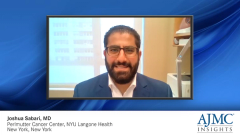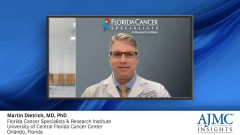
NSCLC Molecular Testing: Part 2
Two medical oncologists break down the role molecular testing has when treating NSCLC, from guidelines to common methods to barriers.
Episodes in this series

Joshua Sabari, MD: I recommend testing up front. All patients with newly diagnosed non-small cell lung cancer should have broad panel NGS [next generation sequencing] in the front-line setting prior to giving or recommending a front-line regimen. One of the major barriers is not having tissue accessible, maybe having a fine needle aspiration where there's not enough cells or DNA to run these assays. I recommend getting large core needle biopsies in patients, if feasible. Also, the tissue turnaround time. Even if you have sufficient tissue and send out to a company or do it internally at your institution, the median turnaround time is about 3–4 weeks, and patients are oftentimes symptomatic. Physicians and clinicians will often start systemic therapy before having the full results of their next generation sequencing.
Another problem is cost and access. In 2022, this is reimbursed by most insurances, as well as Medicare. The other issue is the heterogeneity problem. You might have multiple lesions, and 1 tumor might have a different make up, or 1 lesion might have a different make up than a metastatic foci or site. Lately, over the last 5–6 years, we've been using, we've been using liquid biopsy or circulating tumor DNA based NGS [ in conjunction to tissue based NGS] to try to identify the tumor heterogeneity but also improve on the turnaround time. The median is about 7 days for most commercial assays. I think we're improving upon some of these barriers. At our institution, we're about 99% concordance, meaning that we obtain tissue in all patients. About 75% are obtaining liquid biopsy in the front-line setting. We're only seeing the numbers rise over the last few years. As more targets become available that are actionable, that have matched targeted therapy, it's critical that 100% of our patients with non-small cell lung cancer get the correct biomarker testing.
Martin Dietrich, MD, PhD: Testing for non-small cell lung cancer has redefined the classifications of non-small cell lung cancer. We moved from histologically-based assessments of squamous and non-squamous histologies to genotypically and immunophenotypically define subsets of lung cancer, in which there are plenty. This is not a unified disease. One of the biggest challenges here is to obtain testing for patients up front and really have this as an integrated part of the diagnosis without seeing delays in testing or running into difficulties of obtaining these results in time for the decision making, ensuring that patients that may be presenting more symptomatically have access to guidance through genotypes. We've had less and less problems getting peers to agree to molecular testing. We're still running into the 14-day roll for tissue release for Medicare patients, but this has been also improving, at least from the outpatient side. For the inpatient side, we're still working on some of these parts. There's obviously still a gap of awareness in many geographies where oncogenic drivers may not be as prevalent [especially EGFR and ALK]. The repeat negative experience of not identifying oncogenic drivers may discourage testing, and we've reached a ceiling of testing for about 70% of patients. That is a pretty uniform number across the country [based on] what has been published. That's a number that deserves improvement and where there's still additional opportunities for patients by allowing for these tests to be included in an upfront diagnostic workup—like we do in colon cancer or breast cancer where the main molecular markers are being made available without necessarily having to ask for them. The inclusion of liquid biopsy can certainly help. These would be the multiplexed challenges that we're seeing in the diagnostic testing. We have to understand this as part of the diagnosis and should treat it as such.
Testing modalities have been generationally evolving. We started with single gene tests, PCR- [polymerase chain reaction] and FISH-based [fluorescence in situ hybridization] analyses of molecular alterations, and we've evolved into a space where when we talk about molecular testing and next generation sequencing. Next generation sequencing is not a new technology and certainly not proprietary, but there are features that we need to take into account. One is the amount of experience with a test, the amount of experience interpreting the tests, and the availability. You can buy these machines for local hospitals, and that has been done in some places more successfully than others, but it does depend on a certain amount of volume that is being diagnosed to allow for proper turnaround time, as well as with the proper experience for tissue handling results that are being obtained and interpreted. Smaller groups probably will rely on reference labs. At my group in Florida, we have a comprehensive molecular testing platform within the institution, but, that's the exception. We're 350 physicians jointly working on the development of a molecular lab, and it makes it more feasible. That's a big infrastructural effort with upfront investment that is not easy. We have the opportunity to now make testing available to every patient across the country because of the decentralized nature of commercial laboratory testing for reference analysis. The same is true for liquid biopsy if you don't have a local pathology that would be able to help or cooperate in obtaining these markers in an expedited fashion. Liquid biopsy enables every oncology clinic to obtain comprehensive genomic testing in 7–10 days. There are limitations to the input material of liquid biopsy, which may interfere with some of the sensitivity questions that we have for these assays. Overall, testing is now widely available, and it's dependent on the institutional needs and setups to decide which one would be most feasible. The general idea is to move away from single gene testing and utilize the tissue available for comprehensive platform analysis. The platform is not only broader but also deeper in its analysis, and it allows for the most comprehensive information available for a patient at time of diagnosis.
This transcript has been edited for clarity.
Newsletter
Stay ahead of policy, cost, and value—subscribe to AJMC for expert insights at the intersection of clinical care and health economics.































































